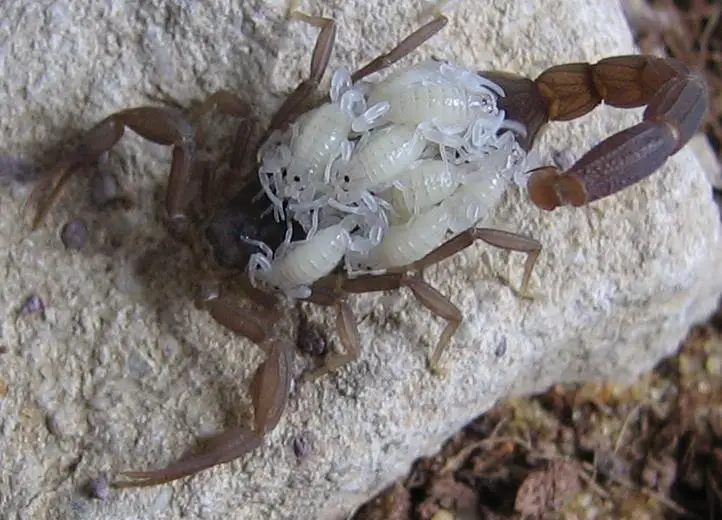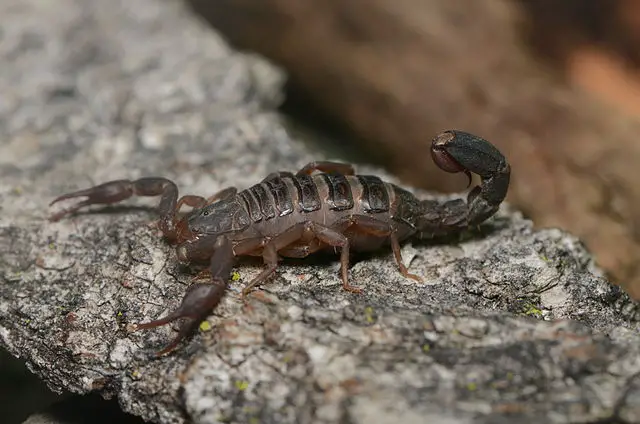It is estimated there are as many as 2000 species of scorpions in the world. They are known to live on all continents except Antarctica. They can be found in tropical, subtropical areas, but are most common in desert areas.
Scorpions are arachnids and cousins to the spider. They are invertebrates – they have an exoskeleton. The body made up of the cephalothorax (a combination of head and thorax), the abdomen, the tail, and 8 walking legs.

The cephalothorax contains the eyes (6 to 8), a mouth, and 2 claws called pedipalps with pinchers at the end. The pedipalps are not legs. They have a segmented tail that curves over their back which has a poisonous tip called a telson, which contains a venom-injecting barb.
Although the scorpion has 6 to 8 eyes, it has very poor vision. They smell or sense vibrations in the ground to locate their prey. They are nocturnal creatures.
Unlike other insects that lay eggs, baby scorpions are born live. The mother may give birth to 2 to 200 live babies. They will craw onto the mother’s back and remain there for several weeks until their exoskeletons harden and until they molt for the first time. Then they are on their own. Unfortunately, if food for the mother is scarce, she will eat her own young.
Scorpions have a fearsome way of attacking their prey. They will grab the prey with their pincers and whip their tail around to sting the victim with its poisonous venom. Scorpions eat insects of all types, lizards, and sometimes rodents.
However, they can only ingest food in a liquid form. They discharge digestive juices from their abdomen into their victim which turns the victim into a liquid form. Then the scorpion sucks in the liquid.

Scorpions also use their poisonous tail tip as defence against predators, such as snakes, lizards, and birds. Their venom is usually only strong enough to kill small creatures and they only attack if they are threatened or if they are hungry. However, there are about 25 species of scorpion that have venom strong enough to kill a human.
When food is scarce as it often is in dry deserts, the scorpion can slow its metabolism so much that it could live for a year without eating. They can survive in the harshest conditions. If they are frozen, they can come back to life when they thaw. They can escape scorching temperatures of the desert but burrowing under the sand.
Scorpions breed during warm months. Scientists believe that the male scorpion can find a female by detecting the pheromone she produces. Mating is very complicated and begins by the male grabbing the female by the pinchers and performing a little dance sideways and back and forth.
When the pair finds a level spot, the male ejects a secretion on the ground and deposits the sperm. Then he pulls her across the secretion so that the sperm can enter her body. If the male stays too close to the female after mating, she will sometimes kill him and eat him. There are two species that scientists have discovered that can produce offspring without mating at all.

Questions:
- What are the parts of a scorpion?
- What is the make-up of the cephalothorax?
- How does the scorpion locate its prey?
- What happens when baby scorpions are born?
- What happens if a scorpion cannot find food?
Answers:
- The body parts of a scorpion are the cephalothorax (a combination of head and thorax), the abdomen, the tail, and 8 walking legs.
- The cephalothorax contains the eyes (6 to 8), a mouth, and 2 claws called pedipalps with pinchers at the end.
- A scorpion locates its prey by sensing vibrations in the ground and by smell.
- Baby scorpions are born live and they crawl onto the mother’s back so that their exoskeletons can dry. They stay on her back until they molt for the first time.
- If a scorpion cannot find food, they slow their metabolism down and they can last for up to a year without eating.